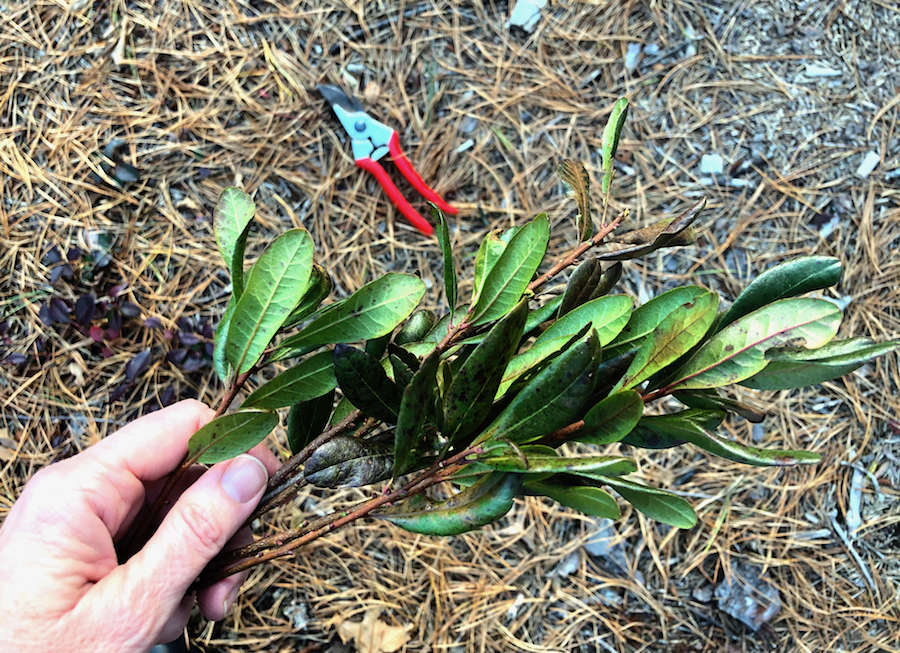
Myrica pensylvanica, also known as bayberry, candleberry, and wax myrtle, is a native species that has long grown across the dunes and woods of the Outer Cape. Unfussy, it tolerates sun or shade, drought, poor soil, and salt spray blowing off the ocean and bay. Myrica pensylvanica makes its own fertilizer, balancing nitrogen as roots spread across the sands. Gripping the earth, keeping it all together against winds and weather, these roots hold strong. It stands out along dune paths at this time of year, and its strength inspires a winter project.
Bayberry is beloved for its sweet, warm, herbal scent. In summer, the shrubs flower inconspicuously against shiny leaves. Flowers give way to berries. It is in these berries, and the leaves, more even than in the flowers, that the plant’s remarkable aromas are concentrated. Now is the time to gather that perfume and bring it indoors.
Candleberry received its name from the colonists. Used for candle and soap making, it was a much more pleasant wax to work with than tallow. Traditional bayberry candles were made by collecting berries in the fall; five pounds of berries could yield about one pound of wax. Because of this small, unpredictable yield, the candles were burned only on special occasions or given as a gift.
You’ll find the bayberry on a winter walk. Come fall, the leaves hang on, their color shifting slightly, deepening and darkening with the change in seasons. Berries cling to brown branches, their color feigning a gray morning just before dawn, the ocean against a snow sky. In winter, birds shelter in the understory, feed on the berries, and flutter through the leaf fall. By now the berries are mostly gone, but along sunny paths you’ll find patches of plants with a few dark green aromatic leaves remaining.
I used fallen leaves found beneath the plants to infuse beeswax to make this candle. A few supplies are needed: beeswax, wicks, and candle jars. I gathered a handful of leaves, placed them in a muslin bag and crushed them, releasing the plant essence. I placed this bag in beeswax and slowly infused it over low heat for a few hours, then poured one sturdy candle.
Keep in mind, a bee has to fly six times around the earth to produce one pound of beeswax, making that harvest just as precious as bayberries; save candle ends and bits to melt back down into new candles.
Bayberry Candles

Ingredients and supplies:
Aside from the leaves you’ll gather on a walk, many of the supplies you need can be found on a swap shack visit. You’ll want to designate these tools for candlemaking.
A metal or glass heat-proof measuring cup (with a good pourer) and large pot to fit it in
8 oz. heat-proof candle jar or canning jar
cotton or hemp wick
clothespin
scale
thermometer
stirring stick or wooden skewer
8 oz. beeswax
big handful leaves
muslin bag or cheesecloth
Instructions:
Use caution when melting and working with beeswax — besides that it can be hard to clean up spills, it is flammable.
Create a small double boiler: place beeswax in the measuring cup and set it in a pot filled with water. Make sure the water level is higher than the wax and maintain that level by adding water as it evaporates.
Put the leaves into a muslin bag, tie tightly, and crush the leaves, then place the bag in the measuring cup with the wax. Heat the wax low and slow (approx. 150 F); it should take about 20 minutes to melt, but continue warming slowly for about 3 hours, to infuse the bayberry aroma into the wax.
Carefully remove muslin bag, squeezing excess wax back into measuring cup. (Disposable gloves work best for this step.) Stir throughly to ensure even temperature before pouring.
Preparing the jars and pouring the candle:
Place wick in jar, securing it to the bottom of the jar with a dab of wax, and allow wax to cure.
Slip the upper end of the wick through the metal eye of a clothespin. Gently pull it taut towards the end of the clothespin and secure.
Make your first pour evenly, quickly, and carefully, leaving space at the top for a second pour.
Allow to cool for 30 minutes to an hour without disturbing. Keep remaining wax over low heat.
Carefully poke four or five holes around the wick with a wooden skewer, then stir the beeswax and make a second pour. Repeat poking and pouring if necessary to fill in cracks that occur while curing. (This tends to happen in colder temperatures. It’s helpful to keep jars warm prior to pouring in cooler weather.)
Allow the candle to cool completely before disturbing.
Remove clothespin, trim wick to a quarter inch in length, and give thanks to the plants and the bees that contributed to your candle.



